Establishing Historical Baselines of Arthropod Assemblages Using Rodent Paleomiddens
Abstract
Aim
Arthropods are under-represented in paleoecological studies but are critical agents in ecological processes. Despite rigorous documentation of diverse arthropod assemblages from ancient rodent (or paleo) middens worldwide, their use for studying ancient arthropod diversity has stalled in recent decades. Here, we review published studies to identify how paleomidden arthropods can be leveraged to address significant questions in ecology and synthesise spatiotemporal trends in ancient arthropod diversity.
Location
Global with a focus on the Americas.
Time Period
From ~40,000 to 100 years before present.
Major Taxa Studied
Fossil arthropods preserved in rodent paleomiddens.
Methods
We identified four primary objectives in ecology that can be advanced using paleomidden arthropod fossils: the reconstruction of ancient biodiversity, the elucidation of mechanisms and processes driving arthropod range shifts, the incorporation of arthropods into ancient trophic webs, and the assessment of adaptive responses to changing environments.
Results
We identified 20 papers reporting arthropod remains, of which 14 provided data suitable for quantitative analyses. Although no significant differences in arthropod community diversity were found across broad geographic regions, substantial differences in community structure were observed. In North America, we also detected a decline in arthropod diversity from 10 to 5 ka BP, driven primarily by the absence of high-diversity assemblages during this period.
Main Conclusions
Paleomidden arthropods remain an underutilised ecological resource that can be leveraged to improve the inferential scope of arthropod research across spatiotemporal gradients. Collaboration between paleo- and neoecologists could help expand the sampling of ancient and modern arthropod communities, particularly those associated with paleomiddens, to create high-resolution datasets spanning important periods in biogeographical history. Paleomidden arthropods will remain a fundamental component for understanding arthropod biodiversity changes in the past, present, and future.


 求助内容:
求助内容: 应助结果提醒方式:
应助结果提醒方式:


